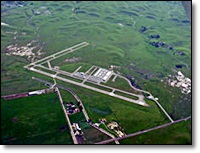 Mariposa Energy Project Power Plant IN – East Altamont Energy Center Power Plant OUT. There will only be one 200 megawatt (MW) power plant located near the Byron Airport.
Mariposa Energy Project Power Plant IN – East Altamont Energy Center Power Plant OUT. There will only be one 200 megawatt (MW) power plant located near the Byron Airport.
On April 13, 2011, the Committee issued the Presiding Member’s Proposed Decision (PMPD) for the MARIPOSA ENERGY PROJECT (MEP), (Docket Number 09-AFC-3) recommends Application for Certification be approved.
East Altamont Energy Center (EAEC) informed the Commission that it no longer intends to build the EAEC and terminated the EAEC certification. (Docket 01-AFC-4C, Docket Log No. 60156, dated 3/23/11, rec’d 3/29/11)
Background
The California Energy Commission (CEC) is the lead agency for all power plants 50 megawatts or greater. MEP ((200 megawatt (MW)) and EAEC ((1,100 megawatt, (MW)) both using gas turbine technologies would produce multiple thermal plume Hazards to aircraft as per FAA Aeronautical Information Manual (AIM), http://www.faa.gov/air_traffic/publications/atpubs/aim/, 7-5-15. Avoid Flight in the Vicinity of Thermal Plumes (Smoke Stacks and Cooling Towers)
The Byron Airports sponsor is Contra Cost County where the airport is physically located but the approach to runway 30 is mostly in Alameda County where both power plants would be located. There is no Airport Land Use agreement between counties. The Contra Costa County Airport Land Use Commission (CCCALUC) made a determination that MEP was inconsistent with the Byron Airport layout and use plans and sent their findings to the CEC. More than twenty five pilots including CALPILOTS made statements before the CCCALUC stating their views on how they use the airport airspace where for the two proposed power plants would be located within the y approach to runway 30 and the within the TERPS RNAV (GPS) approach. CALPILOTS has recommended to both ALUC’s to work together to resolve these issues in the future to protect Byron Airspace.
On October 4, 2010, a Petition to Intervene was filed in the proceedings by CALPILOTS and the Commission GRANTED that Petitioner be placed upon the Proof of Service List as an Intervener. October 20, 201. As an Intervenor, Petitioner is required to file and serve documents on other parties and to follow the Commission’s procedures and orders regarding presenting witnesses and Evidence.
During the CEC proceedings CALPILOTS argued that to have two power plants within the same approach to Byron’s Runway 30 would from an accumulative standpoint be a burden to pilots to would have to avoid two power plants with thermal plumes. The airspace lost would compress airspace needed for not only the approach to runway 30 but critical airspace used for aircraft separation prior to entering the airport patterns at an airport without a control tower. Adding to the complexity of airspace the airport has multiple level traffic patterns to accommodate gliders, ultralights, single engine and multiengine reciprocating aircraft as well as jet aircraft.
The PMPD states that during these proceeding it was determined high velocity plumes as modeled under worst–case conditions do present a potentially significant hazard to aircraft. However, the availability of unrestricted airspace in the project vicinity provides ample opportunity for a pilot to see and avoid over flight of the MEP site, provided advisories of the site location and potential hazard are available to the flying public.
Condition of Certification TRANS-7 will require lighting of the exhaust stacks, consistent with FAA requirements, alerting pilots to the presence of the power plant and reducing the potential for inadvertent over flight of the facility and exposure to high-velocity thermal plumes. Condition of Certification TRANS-8 will provide a means to advise pilots of the potential hazard to flight associated with the project generated exhaust plumes and the need to avoid over flight of the facility below 1,500 feet AGL.
Applicant will initiate requests for the issuance of a Notice to Airmen (NOTAM); amendment of the Airport/Facility Directory; revision of the San Francisco Sectional Chart; and addition of a new remark to the Automated Surface Observing System (ASOS). With these mitigations, impacts to aviation would be less than significant. These measures are advisory, rather than regulatory, and thus do not limit pilot flexibility at the Byron Airport.
The California Pilots Association will have an opportunity to respond to the Presiding Member’s Proposed Decision (PMPD) before an on May 18, 2011. The purpose of this hearing is to consider whether the Energy Commission should adopt, modify, or reject the PMPD and Errata. Parties and members of the public may participate and offer oral and written comments on the PMPD. Identify all comments with “Docket No. 09-AFC-3.”
Wednesday, May 18, 2011
10 a.m.
California Energy CommissionHearing Room A1516
1516 Ninth Street
Sacramento, California 95814
 Andy Wilson, CALPILOTS Director-at-Large
Andy Wilson, CALPILOTS Director-at-Large
[email protected]
